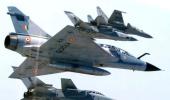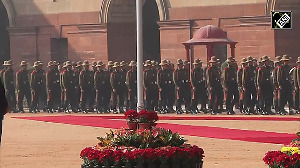Group Captain Murli Menon (retd) reveals how India can neutralise the Pakistan air force's combat capabilities without firing a shot.

The Cold War ended thanks to the Americans virtually 'outspending' the Soviets.
While we should be aiming to do the same in the subcontinental context, there's a golden opportunity presenting itself -- if we wish -- to unravel the mainstay combat capability of the Pakistan air force.
The saga of the F-16, (its albeit doubtful AMRAAM capability not withstanding) and relatively superior standing in the comity of modern fighter aircraft, is still playing out in the subcontinent and indeed the world over.
Contemporary Pakistani commentator Mosharraf Zaidi had lamented a while ago in the New York Times about how Donald J Trump's new Afghan policy and the expected increased pressures on the Pakistani establishment to do more would likely make that country 'lose America'.
His premonition may not wholely be unfounded and his paymasters in the Isloo Military Inc have another think coming possibly .
While the wolf wolf story of Pakistani intransigence in international decent behaviour and double dealing vis a vis the Americans is yet to play out fully, the quantum leaps in the India-US defence strategic partnership of late would ultimately, I believe, sound the death knell for the Pakistani armed forces to remain viable fighting entities.
More specifically, the vector of the fate of the Pakistani air force is heading to the six o' clock region.
The Lockheed-Tata Advanced Systems agreement to produce and export Block 70-72 F-16s under Trump/Modi 'American First'/'Make in India' programmes, could turn out to be India's most 'strategic' defence deal yet.
And this needs to be looked at a new in the following light, Trump or no Trump on the scene! America's dependence on India for its 'Asian pivot' strategy and, of course, its need to play up to the home constituency employment data-wise would tilt the odds in favour of India in a future F-16 deal.
There is a while to go yet as the flyoff between the F-16 and Swedish Saab JAS39 Gripen (or any other contender) is yet to be concluded in favour of either party.
The deal to replace IAF MiG-21s and MiG-27s would involve 126 aircraft initially and several more later should the proposed Lockheed offer to shift its entire production facility from Fort Worth, Texas, to India fructify .
India would have critical control over spares supply and servicing support to 27 F-16 operating airforces.
The most significant, of course, is what such a deal would do to the Pakistan air force!
Fears have been raised in some quarters in India about the obsolescence of the F-16 as an aerial platform. This is unfounded because any machine manufactured anew in India would come with the advantages of zero air frame life and, of course, the first-off-the-block perks of new easily integrateable American weapons and sensors technology.
By way of disadvantages care, of course, needs to be exercised about contractual clauses by way of end user agreements and intellectual property rights.
Conditions for onward transfer of technology and other employment restrictions would need careful consideration by our planners in the IAF and the defence ministry.
Technology wise the F-16s made in India (provided we opt for them!) would have the most updated AESA radar and AMRAAM.
Several other state of the art aerial sensors such as FLIR/LANTIRN, advanced data links for accurate satellite enabled targeting, INGPS, Cubic ACMI aerial combat training pods, helmet cueing, updated electronic warfare suite, high resolution SAR, automatic ground collision avoidance system and the latest F119 engine control technology would be on offer.

Needless to say, these could down the line enable adaptation onto other IAF aerial platforms such as the Light Combat Aircraft and hopefully tranfer of technologies indigenisation through our public sector establishments such as HAL, BEL, LRDE, SDI etc.
Private industry would automatically stand to gain thanks to the Tata involvement and other offset clauses bound to be built into the deal.
The Block 70 F-16s is said to be even superior upgrades wise to the F-16 IN Super Viper which was competing for the IAF's Medium Multi-Role Combat Aircraft (MMRCA) deal earlier (since replaced by Narendra Damodardas Modi's government to government deal with France for 36 flyaway Rafales).
It is even statedly better in terms of life cycle costs, which in any event would be factored into our evaluation process.
Currently, around 5,000 F-16s are in service worldwide and prospects of catering for such a large fleet would more than offset the costs of setting up the manufacturing hub in India.
The overall cost of each F-16 is stated to be around $10 million cheaper than its competitor.
Thus, we get a 4.5 generation cost effective fighter plane which is a proven warhorse.
Shifting the manufacturing base to India is expected to offer some reductions in maintenance and spare parts costs.
What also needs factoring in is that several thousand additional jobs would be retained in the US earlier on and transferred to India later as the facilities take shape.
Evaluation of technical parameters, performance data and costing is something the IAF has by now mastered what with the Rafale flyoff and lessons from other inductions worldwide.
But a solid strategic pay-off for India would be the fact that our chief adversary, the Pakistan air force, operate around 85 F-16 aircraft, these machines being its mainstay.
Should the production facilities be shifted to India, the Pakistan air force would be practically writing off its F-16 fleet, relying mainly on desperate spares from countries such as the UAE, Turkey or Jordan.
Smart business deals and contracts by us could virtually scuttle even such avenues for the Pakistan air force to sustain its F-16s.
That would leave Pakistan with the Chinese JF-17s (around 85) and outdated Mirage 3s in its fighter inventory.
There is no gain saying the difficulties in integrating modern armaments and sensors onto these platforms.
Besides the economic bonanza of a large worldwide supply, maintenance orders would provide us with a strategic pay-off by way of stifling and, in due course, grounding the state of the art aerial fighting capabilities of our chief adversary.
This would directly contribute to the ambit of our economic warfare against our terror- sponsoring neighbour and neutralise the Pakistan air force's combat capabilities even without firing a shot!!
Post Pulwama and our marked political policy shift towards pre-emption, it is to be hoped that defence spending would at least be upped to 3% of GDP -- maybe even higher -- to cater for mandatory capital budgets of all three defence services.










